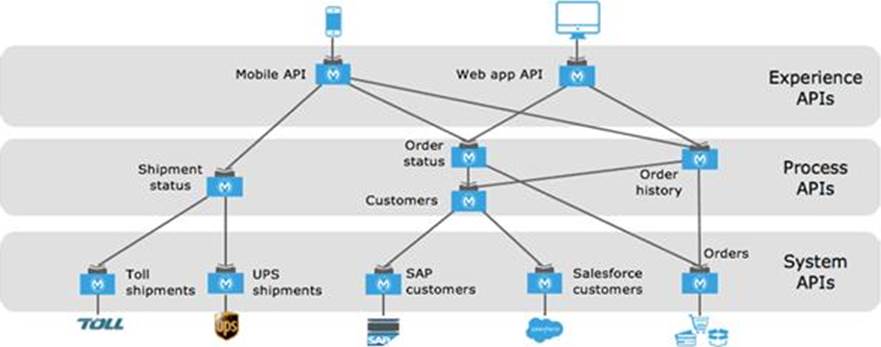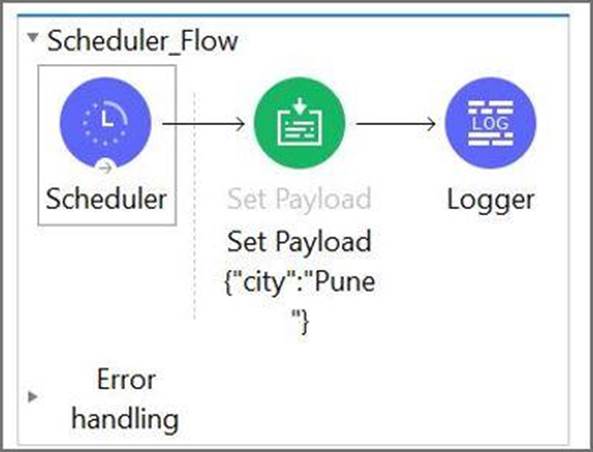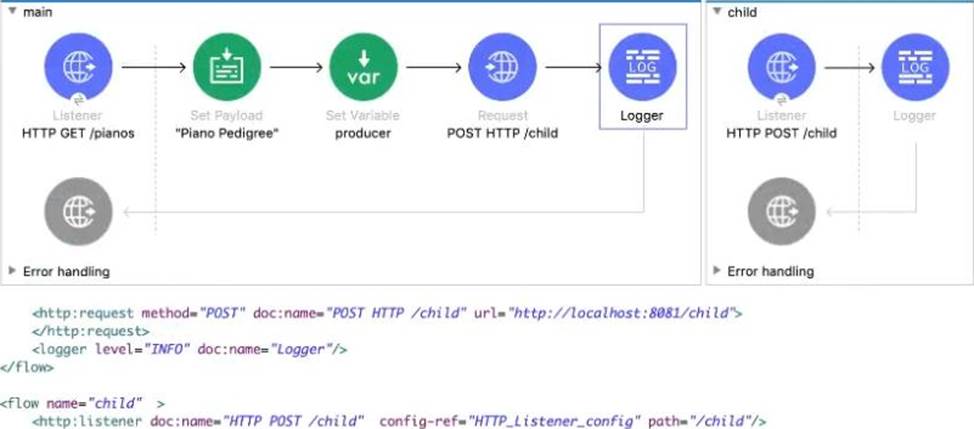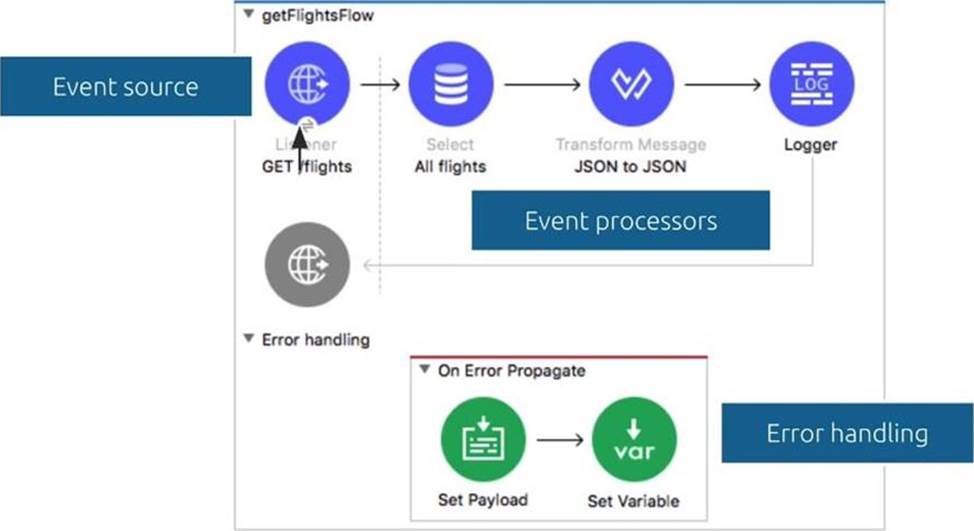Mulesoft MuleSoft Certified Developer-Level 1 MuleSoft Certified Developer-Level 1 (Mule 4) Online Training
Mulesoft MuleSoft Certified Developer-Level 1 Online Training
The questions for MuleSoft Certified Developer-Level 1 were last updated at Jan 27,2025.
- Exam Code: MuleSoft Certified Developer-Level 1
- Exam Name: MuleSoft Certified Developer-Level 1 (Mule 4)
- Certification Provider: Mulesoft
- Latest update: Jan 27,2025
What MuleSoft API-led connectivity layer is intended to expose part of a backend database without business logic?
- A . Data layer
- B . Process layer
- C . Experience layer
- D . System layer
D
Explanation:
Correct answer is System layer
System APIs provide a means for insulating the data consumers from the complexity or changes to the underlying backend systems.
MuleSoft recommends three-layered approach to API-led connectivity, highlighting the three layers:
* System APIs
* Process APIs
* Experience APIs
System APIs are the core systems of record underlying core systems of record (e.g. ERPs, key customer and billing systems, databases, etc.). Process APIs allow you to define a common process which the organization can share, and these APIs perform specific functions, provide access to non-central data, and may be built by either Central IT or Line of Business IT. And finally, the Experience APIs are the means by which data can be reconfigured so that it is most easily consumed by its intended audience, all from a common data source.
The three-layered structure allows for a seamless flow of data from systems of record to new experiences, and allows for reusability of assets rather than point to point connections. This approach provides a distributed and tailored approach to architecture, greater flexibility through loose coupling, and deeper operational visibility into what is being built.

Diagram
MuleSoft MCD-Level-1 : Practice Test Description automatically generated
What MuleSoft API-led connectivity layer is intended to expose part of a backend database without business logic?
- A . Data layer
- B . Process layer
- C . Experience layer
- D . System layer
D
Explanation:
Correct answer is System layer
System APIs provide a means for insulating the data consumers from the complexity or changes to the underlying backend systems.
MuleSoft recommends three-layered approach to API-led connectivity, highlighting the three layers:
* System APIs
* Process APIs
* Experience APIs
System APIs are the core systems of record underlying core systems of record (e.g. ERPs, key customer and billing systems, databases, etc.). Process APIs allow you to define a common process which the organization can share, and these APIs perform specific functions, provide access to non-central data, and may be built by either Central IT or Line of Business IT. And finally, the Experience APIs are the means by which data can be reconfigured so that it is most easily consumed by its intended audience, all from a common data source.
The three-layered structure allows for a seamless flow of data from systems of record to new experiences, and allows for reusability of assets rather than point to point connections. This approach provides a distributed and tailored approach to architecture, greater flexibility through loose coupling, and deeper operational visibility into what is being built.

Diagram
MuleSoft MCD-Level-1 : Practice Test Description automatically generated
What MuleSoft API-led connectivity layer is intended to expose part of a backend database without business logic?
- A . Data layer
- B . Process layer
- C . Experience layer
- D . System layer
D
Explanation:
Correct answer is System layer
System APIs provide a means for insulating the data consumers from the complexity or changes to the underlying backend systems.
MuleSoft recommends three-layered approach to API-led connectivity, highlighting the three layers:
* System APIs
* Process APIs
* Experience APIs
System APIs are the core systems of record underlying core systems of record (e.g. ERPs, key customer and billing systems, databases, etc.). Process APIs allow you to define a common process which the organization can share, and these APIs perform specific functions, provide access to non-central data, and may be built by either Central IT or Line of Business IT. And finally, the Experience APIs are the means by which data can be reconfigured so that it is most easily consumed by its intended audience, all from a common data source.
The three-layered structure allows for a seamless flow of data from systems of record to new experiences, and allows for reusability of assets rather than point to point connections. This approach provides a distributed and tailored approach to architecture, greater flexibility through loose coupling, and deeper operational visibility into what is being built.

Diagram
MuleSoft MCD-Level-1 : Practice Test Description automatically generated
What MuleSoft API-led connectivity layer is intended to expose part of a backend database without business logic?
- A . Data layer
- B . Process layer
- C . Experience layer
- D . System layer
D
Explanation:
Correct answer is System layer
System APIs provide a means for insulating the data consumers from the complexity or changes to the underlying backend systems.
MuleSoft recommends three-layered approach to API-led connectivity, highlighting the three layers:
* System APIs
* Process APIs
* Experience APIs
System APIs are the core systems of record underlying core systems of record (e.g. ERPs, key customer and billing systems, databases, etc.). Process APIs allow you to define a common process which the organization can share, and these APIs perform specific functions, provide access to non-central data, and may be built by either Central IT or Line of Business IT. And finally, the Experience APIs are the means by which data can be reconfigured so that it is most easily consumed by its intended audience, all from a common data source.
The three-layered structure allows for a seamless flow of data from systems of record to new experiences, and allows for reusability of assets rather than point to point connections. This approach provides a distributed and tailored approach to architecture, greater flexibility through loose coupling, and deeper operational visibility into what is being built.

Diagram
MuleSoft MCD-Level-1 : Practice Test Description automatically generated
What MuleSoft API-led connectivity layer is intended to expose part of a backend database without business logic?
- A . Data layer
- B . Process layer
- C . Experience layer
- D . System layer
D
Explanation:
Correct answer is System layer
System APIs provide a means for insulating the data consumers from the complexity or changes to the underlying backend systems.
MuleSoft recommends three-layered approach to API-led connectivity, highlighting the three layers:
* System APIs
* Process APIs
* Experience APIs
System APIs are the core systems of record underlying core systems of record (e.g. ERPs, key customer and billing systems, databases, etc.). Process APIs allow you to define a common process which the organization can share, and these APIs perform specific functions, provide access to non-central data, and may be built by either Central IT or Line of Business IT. And finally, the Experience APIs are the means by which data can be reconfigured so that it is most easily consumed by its intended audience, all from a common data source.
The three-layered structure allows for a seamless flow of data from systems of record to new experiences, and allows for reusability of assets rather than point to point connections. This approach provides a distributed and tailored approach to architecture, greater flexibility through loose coupling, and deeper operational visibility into what is being built.

Diagram
MuleSoft MCD-Level-1 : Practice Test Description automatically generated
/{customerId}:
Explanation:
Correct answer is below as it follows the correct syntax.
/customers:
/{customerId}:
get:
Refer to exhibits.

What message should be added to Logger component so that logger prints "The city is Pune" (Double quote should not be part of logged message)?
- A . #["The city is" ++ payload.City]
- B . The city is + #[payload.City]
- C . The city is #[payload.City]
- D . #[The city is ${payload.City}
C
Explanation:
Correct answer is The city is #[payload.City]
Answer can get confused with the option #["The city is" ++ payload.City] But note that this option will not print the space between is and city name. This will print The city isPune
Refer to the exhibits.

The main flow contains an HTTP Request in the middle of the flow.
The HTTP Listeners and HTTP Request use default configurations.
A web client submits a request to the main flow’s HTTP Listener that includes query parameters for the pedigree of the piano.
What values are accessible to the Logger component at the end of the main flow?
- A . payload
- B . payload
pedigree query params - C . payload producer var
- D . payload
pedigree query params producer var
C
Explanation:
In this case as outbound call is made using HTTP: POST /child, all attributes will be replaced by this invocation. Hence query parameter will not be accessible at logger. Hence correct answer is option 2
What is minimal requirement in a flow for a Mule application to compile?
- A . Event Source
- B . Event Processors
- C . Error handlers
- D . Source and processors both
B
Explanation:
Process section is must to get compiles. Process section must have one or more processors

Diagram
Description automatically generated
What is minimal requirement in a flow for a Mule application to compile?
- A . Event Source
- B . Event Processors
- C . Error handlers
- D . Source and processors both
B
Explanation:
Process section is must to get compiles. Process section must have one or more processors

Diagram
Description automatically generated
Latest MuleSoft Certified Developer-Level 1 Dumps Valid Version with 99 Q&As
Latest And Valid Q&A | Instant Download | Once Fail, Full Refund

